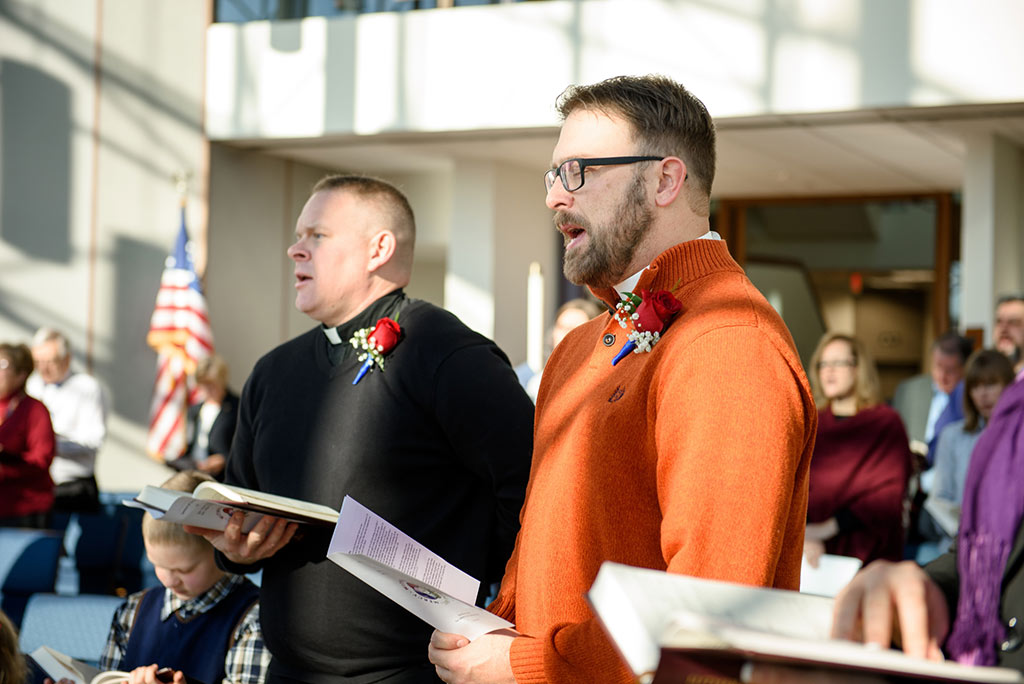By Megan K. Mertz

Jan. 12 was a “monumental moment” in LCMS missions, according to the Rev. Steven Schave, director of LCMS Church Planting and Urban & Inner-City Mission.
During a service held at the LCMS International Center that day, the Rev. Peter Burfeind and the Rev. Adam DeGroot were blessed and sent out as the first two “Mission Field: USA” national missionaries.
New church-planting initiative
Mission Field: USA is the LCMS Office of National Mission’s (ONM) new church-planting initiative. It seeks to support congregations, circuits and districts as they plant new Lutheran churches.
“A lot of congregations are interested in planting churches,” said Schave, who directs the initiative. “They see the need for it, but they don’t know where to start. We’re hoping Mission Field: USA will offer our districts and congregations the support they need for their own initiatives.”
A new Web page — lcms.org/churchplanting — is now available to provide information and resources for those interested in this endeavor. A church-planting manual and training modules for different aspects of the church-planting process are among the new resources currently being developed.
“The ONM is so excited for these new opportunities in church planting,” said the Rev. Bart Day, ONM executive director. “It is our prayer that our renewed emphasis on church planting and revitalization will help lift up this important work across the Synod. By partnering with districts, we will be able to support domestic missionaries in hard-to-reach places where the Gospel needs to be preached.”
New national missionaries
Among these “hard-to-reach places” are Toledo, Ohio, and Philadelphia, where the two new national missionaries are leading very diverse ministries.
Burfeind serves as missionary pastor to Toledo, where he leads Holy Cross Lutheran Church and serves as campus pastor at the University of Toledo. In this role, he guides a student group called Engineers for Christ in projects to help homeowners in the community. The congregation has just recently rented space, and Burfeind hopes to start an after-school program for children in the community.
DeGroot serves in a similar role in Philadelphia, where he leads Shepherd of the City Lutheran Church, works with Philadelphia Lutheran Ministries, organizes outreach efforts to immigrants and engages with students at four local universities.
When he arrived a year and half ago, Shepherd of the City only had three confirmed members. But, DeGroot said, that number is growing and is now at 15.
“Philadelphia has about 1.5 million people … but there are only about 85 Lutheran Church—Missouri Synod members in the whole city,” he said. “There is a very pressing need for substantive outreach to the people of the city of Philadelphia, not just in terms of social outreach but also in terms of Word and Sacrament ministry.”
Burfeind also sees some of the same opportunities and challenges in Toledo.
“On one hand, it’s exciting, but on the other, it’s extremely stressful,” he said. “There’s racial tension in the country right now. Millennials are notoriously dropping away [from the church]. And we have an aging church. But now we’re here in the frontier, trying to figure out where we’re going.”
Although the work can seem daunting, DeGroot said he has been encouraged by the practical assistance he received during the Jan. 11-12 orientation in St. Louis.
“We have been equipped to do everything that the Lord would ask us to do in these particular places,” he continued. “There is nothing in the cities to fear because our Lord goes before us, He fights for us and He is the one who provides these things for us.”
A new model for national missions
Burfeind’s and DeGroot’s transition to serving through Mission Field: USA means their salaries and benefits will be covered by a network of support from across the Synod — the same model that is used with international missionaries.
“These missionaries will tell their stories, visiting congregations and schools. And as they do, they will build a network of people who love them, pray for them and financially support them,” Day said. “We believe that the Synod will respond to domestic missionaries. People see the tremendous opportunities we have in our own backyard for mission work.”
The Rev. Dr. Jamison J. Hardy, president of the LCMS English District, the district in which Burfeind serves, called this collaboration with the ONM “an absolute joy.”
“We are thrilled to partner with the Synod in the harvest field in Toledo and count it a blessing to be a part of this pilot project,” Hardy continued. “Pastor Burfeind will do great work for the sake of the Gospel, and we look forward to the blessings of the Holy Spirit.”
Schave said he is currently working to send two more national missionaries to underserved yet vital ministries: one to Brownsville, Texas, and one to Ferguson, Mo.
“Our commitment is to reaching into the margins, to going into the gritty, challenging locations where people so desperately need to hear the Gospel,” Schave said. “Pioneers are needed to go into the frontier of America to reach out in mission to new places to populations that are different from the typical LCMS.”
Megan K. Mertz (megan.mertz@lcms.org) is a staff writer and managing editor of Lutherans Engage the World with LCMS Communications.
Posted Jan. 15, 2016 / Updated Jan. 19, 2016